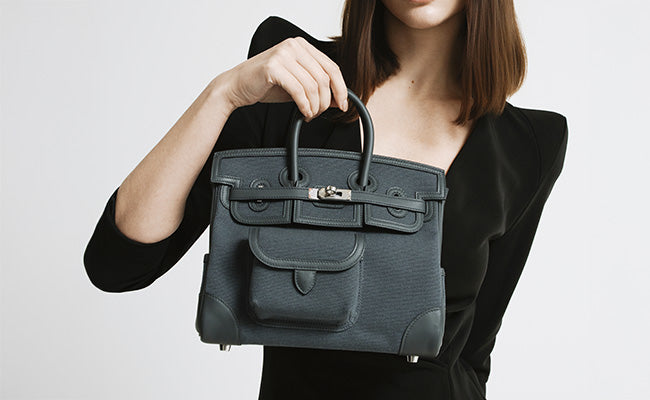
Signature on Delivery: Why It Matters for Five‑Figure Parcels
Check out our Hermès collection and Birkin bags!
When you're spending five figures (or more) on something special, a Hermès Birkin, a rare watch, whatever your flavor, the last thing you want is to come home and find your doorstep empty.
Package theft is rampant across Canada these days, and leaving expensive stuff unattended is practically an open invitation for thieves.
Signature on delivery flips the script. Your shipment goes from “easy target” to a secure handoff that demands ID and creates a paper trail. Only authorized people can receive the package, and the carrier records the name, signature, and delivery details to prove it.
If you know a $50,000 handbag deserves more than standard Amazon-level protection, signature requirements aren't just a nice-to-have. They’re a must. The extra fee is nothing compared to the agony of losing a one-of-a-kind item to porch pirates or delivery blunders.
Key Takeaways
- Signature delivery stops package theft by requiring a personal handoff and ID check for high-value parcels
- Carriers log recipient details and signatures as legal proof for insurance and disputes
- The added security cost is minor next to the risk of losing luxury goods to theft or misdelivery
The Importance of Signature on Delivery for High-Value Parcels
When you’re dropping five figures on a Birkin or Kelly, signature on delivery isn’t up for debate. The stakes are just too high.
Protecting Against Loss and Theft
Expensive parcels face real risks at the last mile. Thieves know what to look for, and luxury deliveries left outside are easy pickings.
Signature requirements put a stop to that. The carrier hands your item directly to someone authorized. No leaving it on the porch.
Canada Post’s Signature service makes sure there’s a personal hand-off, and they log the recipient’s name and signature as proof.
For anything worth $10,000 or more, this protection is non-negotiable. It’s not just about the item. It’s about the money on the line.
Timing matters, too. Theft spikes during holidays, so signature services become even more crucial.
Key protection perks:
- No more unattended deliveries
- Accountability for delivery staff
- Fewer theft opportunities
- A clear, documented handover
Facilitating Claims and Liability
Signature confirmation gives you the legal backup you need if something goes wrong. Without that proof, fixing delivery issues can get messy.
Insurance companies usually want delivery verification before processing claims. The signature is hard evidence your parcel arrived.
This protects both buyers and sellers from finger-pointing. If a client says their luxury bag never showed, the signature record settles it.
FedEx and UPS offer several signature options, even requiring government-issued ID for adult signature deliveries.
Signed confirmation carries serious legal weight. It can even stop scammers in their tracks, since they can’t argue with the documentation.
For sellers, signature services slash chargeback risks. Credit card companies accept signed delivery as proof you did your part.
Peace of Mind for Buyers and Sellers
There’s nothing quite like the relief of knowing your five-figure purchase is properly protected. That small signature fee? Totally worth it.
Clients buying luxury goods expect this level of care. It shows you’re serious about protecting their investment from start to finish.
Sellers also get peace of mind. Signature requirements mean fewer false claims and a clear trail of responsibility.
Both sides can track the delivery in real time and see when the signature lands.
This transparency builds trust. When someone spends big on luxury, they want every safeguard possible.
Many sellers just make signature delivery standard for pricey items. Why risk it?
How Signature Requirements Work with Commercial Carriers
Major carriers have built out some pretty involved systems for signature-required shipments, especially for high-value stuff. Each one does things a little differently, with their own rules and tech.
Major Commercial Carrier Policies
FedEx recommends signature services for anything over $500, but you can request signature service for any package. “Direct Signature Required” means only the addressee signs; “Indirect Signature Required” lets anyone at the address sign.
UPS offers signature confirmation for packages over $750. They offer three levels: standard (anyone signs), adult (21+), and adult restricted (only a specific person).
DHL Express requires signatures for all international shipments and for domestic ones over $100. They’ve got standard, adult, and “No Signature Required” options for trusted spots.
Canada Post includes signature service with their Priority and Xpresspost Certified options, logging both name and signature for a permanent record.
Pricing varies. FedEx and UPS usually charge $5–8 CAD for signature upgrades; Canada Post throws it in with their premium services.
Courier Procedures for Signature Collection
Couriers follow strict steps when handing over valuable packages. For adult signature confirmation, they check government-issued photo ID before releasing the parcel.
They use handheld devices to capture the signature digitally. Logging the time, location, and address right then and there.
If nobody’s around to sign, they’ll try up to three times. After that, the package waits at a depot or pickup spot for 5–10 business days.
Proxy signatures work for standard signature service. Anyone at the address who looks 18+ can sign.
With restricted delivery, only the named recipient can sign. If that person’s not there, no dice. Family or coworkers can’t step in.
Couriers also snap a photo of the package at delivery when signature service is used. That’s extra proof the item arrived in good shape.
Technology: EDI, ACI, and Real-Time Tracking
Electronic Data Interchange (EDI) lets carriers swap shipping details instantly with retailers and customs. When you send luxury items needing signatures, EDI pushes out package info, value, and signature requirements to everyone involved.
Advance Commercial Information (ACI) alerts border agents about incoming high-value shipments before they land. This speeds up customs for signature-required packages.
Real-time tracking ties into EDI and ACI. You can watch your parcel’s every move, while carriers update customs and delivery details.
Couriers’ handheld devices link directly to these systems. The second they get a signature, it uploads and triggers notifications.
GPS integration stamps the exact location on every signature. This helps settle any disputes about where the package went and gives courts solid evidence if things get legal.
Some carriers are even trying out blockchain for signature records. Once logged, those signatures can’t be changed, adding another layer of security for five-figure shipments.
Critical Documents and Labelling for Secure Delivery
Getting the paperwork and labelling right is the backbone of secure luxury parcel delivery. Every detail has to line up with carrier rules and international laws to make sure your high-value item gets where it’s supposed to go.
Preparing Accurate Shipping Labels
When you’re shipping a $50,000 Birkin internationally, every letter on that label matters. One typo? Your bag could end up halfway around the world.
Always include full recipient info: legal name, complete address with postal codes, and a working phone number. For luxury shipments, don’t abbreviate or leave anything out.
Must-haves for the label:
- Full recipient name (as shown on ID)
- Complete street address, unit numbers included
- City, province/state, and postal/ZIP code
- Country spelled out
- Phone number with country code
Stick to the carrier’s official shipping labels, not handwritten ones. The official labels come with tracking numbers and barcodes that work with signature services.
Double-check address formats for international shipments. Canadians need “A1A 1A1” postal codes; Americans need five or nine-digit ZIPs.
Completing Required Customs Forms
Shipping luxury goods across borders? Customs paperwork has to be spot-on. Understating the value to dodge duties isn’t just risky. It’ll void your insurance.
Key customs details:
- Accurate declared value: Use the real purchase price or market value
- Detailed item description: “Hermès leather handbag” beats just “bag”
- Country of origin: Where it was made
- HS code: The right code for luxury goods
Use CN22 forms for low-value letter-post items and CN23 for higher values or parcels. Five-figure parcels? Always go with CN23.
Attach supporting docs: receipts, authenticity papers, appraisals. These help both sender and recipient if customs has questions.
Don’t mark “gift” unless it truly is. Customs can check purchase history, and false declarations can get you into trouble.
Special Handling Instructions for Five-Figure Parcels
Luxury shipments need more than just standard delivery. Use every security option you can.
Essentials for high-value parcels:
- Adult signature required (with ID check)
- Insurance for the full declared value
- Real-time tracking
- Secure storage if delivery fails
Add “Do Not Safe Drop” instructions. Never let high-value items sit unattended, no matter how safe the neighborhood feels.
Consider indirect signatures if you want trusted neighbors or building staff to sign when you’re away.
Stick with plain, unbranded packaging. Designer boxes attract attention you don’t want.
Coordinate delivery times with the recipient. Share tracking numbers and delivery windows so someone’s there to sign.
Managing Risk and Liability for High-Value Shipments
When you’re shipping or receiving something like a Birkin or limited-edition Kelly, knowing who’s responsible at every step is critical. Standard carrier coverage usually isn’t enough for luxury goods, so you need solid insurance and clear agreements.
Assigning Responsibility for Loss or Damage
Carriers set strict liability limits. Most cap out at $100 to $500 per package, no matter what’s inside.
If your $25,000 Birkin disappears, you’ll get back a fraction of its value from standard coverage. That’s just not good enough.
Main liability players:
- Shipper (sender)
- Carrier (shipping company)
- Recipient (buyer)
- Insurance provider (if you have extra coverage)
Figure out who’s responsible at each stage before you ship. Some luxury retailers keep liability until delivery, others pass it off once it leaves their hands.
Document everything: photos, serial numbers, authenticity certificates. Do this before shipping or after receiving, just in case.
Understanding Insurance Options
Standard carrier insurance barely scratches the surface for luxury items. You need coverage that matches your actual replacement cost.
All-risk cargo insurance is the gold standard for high-value shipments. It covers almost everything except war or nuclear disasters.
Coverage breakdown:
| Type | Protection Level | Cost | Best For |
|---|---|---|---|
| Carrier Standard | $100-500 max | Included | Low-value items |
| Declared Value | Up to item value | 1-3% of value | Mid-range items |
| All-Risk Cargo | Full replacement | 0.5-2% of value | Luxury goods |
Private insurance often costs less than carrier-declared value and offers better coverage. If you’re spending big, don’t cut corners here.
Some credit cards include shipping protection, but the fine print can be brutal. Many exclude luxury goods or have tough documentation rules.
Dealing With Overages and Exception Scenarios
Luxury items often hit carrier limits for weight, size, or value, leading to extra fees or gaps in coverage.
High-value shipments might get flagged for extra security, causing delays or rerouting.
Common overage triggers:
- Too heavy for standard rates
- Declared value above carrier limits
- Big dimensional weight
- Shipping to restricted zones
Expect extra fees when shipping luxury goods. They’re not surprises, just the cost of added security.
Some carriers put high-value packages on hold for more verification before final delivery. It’s a hassle, but it does cut theft risks.
Build in extra time for shipping. Last-minute gifts can get held up for security checks, but that’s still better than losing the item.
Parcel Categories Requiring Special Attention
Five-figure parcels aren’t all the same. They cover everything from luxury collectibles to hazardous materials. Each type brings its own challenges and needs signature confirmation to protect both sender and recipient.
Valuable Items and Restricted Goods
When shipping valuable stuff, think tens of thousands in worth, signature requirements just aren't optional. Luxury watches, rare stamps, collectible china: these are magnets for package thieves, and everyone knows it.
Carriers usually insist on signatures for parcels over $500 in declared value. Still, it's smart to request this service for any high-value shipment, just to be sure it gets treated right.
Common valuable items needing signatures:
- Designer handbags and accessories
- Vintage stamps and coin collections
- Fine china and porcelain pieces
- Precious metals and jewellery
- Electronic devices over $1,000
Restricted goods like tobacco face extra hurdles. These shipments often need an adult signature, so the recipient has to be 18+ and show government-issued ID.
The signature acts as legal proof that the right person got the package. If you ever need to file an insurance claim or argue about a missing delivery, this record can be a lifesaver.
Shipping Fragile and Prohibited Items
Glass and china don't just want bubble wrap. They demand extra care and signature confirmation. These fragile things need careful handling from start to finish.
Paint products and inks land in the restricted category because they're liquids. Many carriers call these hazardous materials, which means you get hit with signature requirements and extra handling fees.
Fragile items needing signatures:
- Crystal glassware and sculptures
- Antique china sets
- Oil paintings and artwork
- Scientific instruments
- Vintage bottles and decanters
It's important to declare fragile contents accurately on shipping labels. If you fudge the details, you could lose insurance coverage and face liability if something breaks.
Some shipments, like certain plants, need phytosanitary certificates and agricultural inspections. These always require signatures, so the paperwork gets handed off properly.
Unique Regulations for Dangerous Goods
Dangerous goods aren't always obvious. Plenty of luxury items have components that set off special shipping rules and force you into signature collection.
Classification levels for dangerous goods:
| Class | Examples | Signature Type |
|---|---|---|
| Class 3 | Perfumes, nail polish | Adult signature |
| Class 8 | Leather cleaners, batteries | Standard signature |
| Class 9 | Lithium batteries, dry ice | Restricted delivery |
Live animals? That's a whole different game. Shipping them means temperature checks and instant delivery confirmation. The courier has to make sure someone qualified receives them.
If you're shipping paint in big quantities, you need to declare it as hazardous material. Some carriers only allow these deliveries to businesses, and they'll want a signature from trained staff.
Even things like vintage perfumes or collectible inks can trigger dangerous goods protocols. High alcohol content or weird chemicals mean adult signatures and extra care.
Always check carrier guidelines before sending anything potentially hazardous. Getting the classification right keeps things moving and helps you avoid headaches with safety regulations.
Client Experience: Navigating Signature Deliveries with Ease
Handling signature deliveries for luxury buys is all about clear communication. Once you get the booking and tracking process, it all feels less intimidating.
Booking and Scheduling Deliveries
If you're buying a Birkin or a limited-edition Kelly, delivery drama is the last thing you want. Most luxury retailers tack on signature requirements for pricey parcels, but it's worth double-checking at checkout.
For these items, Adult signature required is the gold standard. The courier checks ID before handing over your new treasure.
You'll need to give accurate contact info:
- Main phone number for delivery coordination
- Backup contact in case you can't be reached
- Any special instructions or preferred delivery times
A lot of couriers now let you schedule delivery windows through their apps or websites. Picking a 2-4 hour slot sure beats wasting a whole day waiting for your latest splurge.
Traveling? You can reroute the delivery to your office or authorize someone else to sign, as long as they have proper ID.
Tracking and Confirming Receipt
Real-time tracking takes the edge off waiting. Major couriers let you see exactly when your delivery's coming and provide signature confirmation.
You'll get updates for every stage: out for delivery, delivery attempted, and signature obtained.
Digital signature capture means you can check who signed for your package minutes after it lands.
Delivery confirmation emails usually include:
- Photo of the signed receipt
- GPS coordinates of where it landed
- Timestamp and recipient's name
- Reference number for follow-up
Missed the delivery? No big deal. You can reschedule with the courier's app, which sure beats endless calls to customer service.
Frequently Asked Questions
Here are the burning questions about signature delivery for luxury items, from what happens at your door to keeping those Birkins safe.
What exactly does 'Signature on Delivery' entail for high-end parcel services?
Signature on delivery means someone has to physically sign when your package arrives. The courier records the signature and the name, proving it went to a real person.
For luxury stuff, this usually means Adult Signature Required (ASR) or Direct Signature Required (DSR). ASR makes sure the signer is 18 or older, while DSR means only the addressee can sign.
If nobody's home, your $15,000 Hermès Kelly isn't getting left on the porch. Couriers try up to three times, then hold it at a secure spot for pickup.
How does requiring a signature upon delivery enhance the security of luxury item shipments?
Signature requirements stop porch piracy cold. Your designer bag won't end up as free advertising for thieves.
The signature creates an official record. Timestamp, recipient details, the works. If there's ever a dispute, you have proof of exactly when and to whom your item was delivered.
Carriers also check IDs for high-value deliveries, so random people can't just walk off with your expensive stuff.
Can the delivery of luxury goods be insured, and how does signature confirmation play into that?
You can insure most luxury shipments. Sometimes up to $100,000, depending on the carrier. Signature confirmation is your best friend when filing insurance claims for lost or stolen packages.
Without a signature, insurance companies may just deny your claim. The signature is your proof that the item was delivered right.
A lot of high-end retailers automatically add signature requirements and extra insurance for big purchases. It protects both you and them from major losses.
Are there any alternatives to 'Signature on Delivery' for ensuring the safe arrival of opulent parcels?
If you can't be home to sign, secure pickup locations are a solid alternative. Carriers team up with stores, post offices, or special pickup centers where you can collect your package.
Some buildings let you have things delivered to the concierge, who signs and keeps it safe until you pick it up.
FedEx and others let you schedule delivery windows, so you can be there to sign. Handy for those can’t-miss, high-value deliveries.
Why might high-value item deliveries without a signature confirmation be a risky move?
Leaving pricey packages without a signature is just asking for trouble. Designer brands use boxes that practically shout "steal me" to anyone passing by.
If something goes wrong, you have no backup. Without a signature, it's your word versus the carrier’s on whether it arrived.
Weather can wreck expensive items left outside, too. Rain, snow, or heat can turn a luxury purchase into a loss.
And good luck with insurance claims if you don't have delivery confirmation. Carriers and retailers aren't likely to take responsibility for items they say were delivered but you never saw.
What steps should one take if their swanky purchase arrives with a signature but is still compromised?
First things first, grab your phone and snap photos of everything. The outer box, the inside packaging, and the item itself. Get a few angles, especially if there’s visible damage or something just feels off.
Reach out to the retailer right away. In my experience, luxury brands usually care a lot about keeping customers happy, so they're likely to investigate quickly and help sort things out.
Next, file a claim with the shipping carrier. Don’t wait too long. Most carriers want damage claims within a day or two. When you contact them, share your photos, the receipt, and any delivery confirmation you’ve got.
Hang on to all the original packaging. Sometimes, insurance folks or brand reps want to see everything before they process a claim or send a replacement. It can feel like a hassle, but it speeds things up if you have it all ready.




